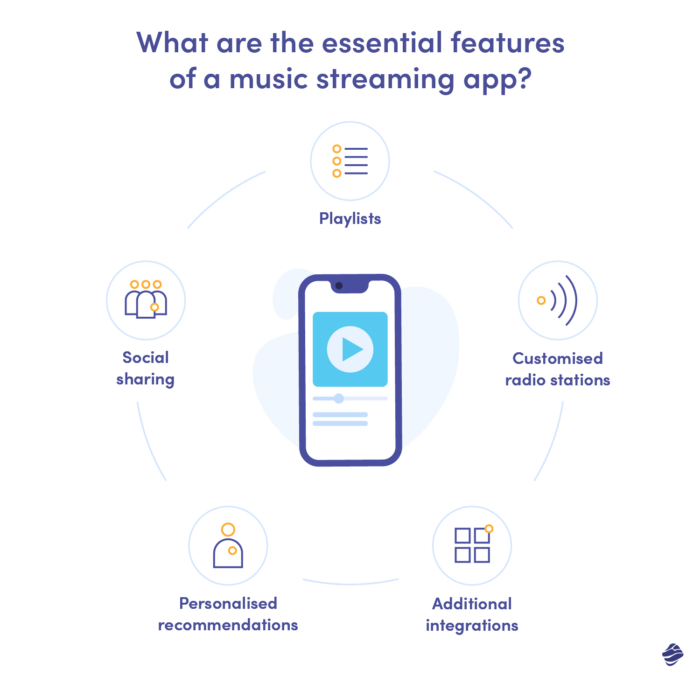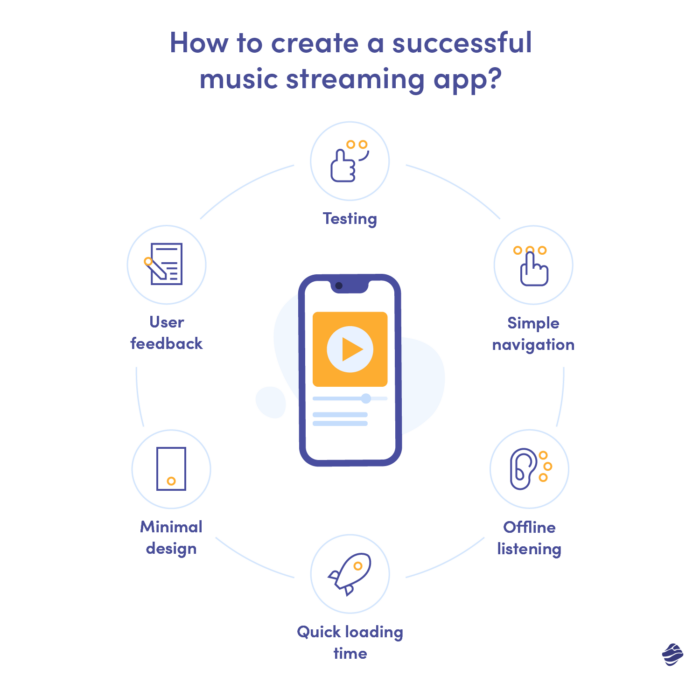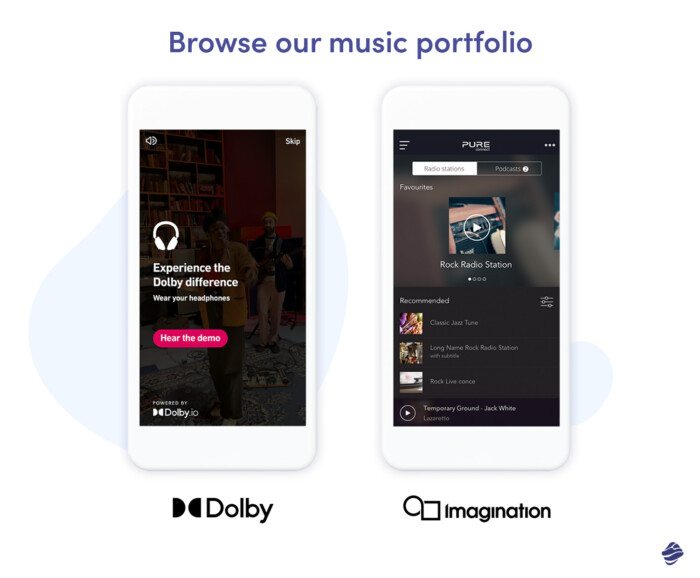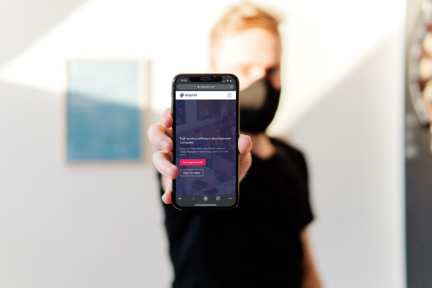The global music streaming industry is projected to grow by 5.14% (2023-2027) resulting in a market volume of $18.56 billion in 2027. The industry is booming, and it’s no surprise why. With the convenience of being able to listen to any song, any time, anywhere without downloading files, music apps have become the go-to for music lovers. But how exactly can you create a music streaming app?
Creating a successful music streaming app is not an easy task. With so much competition in the market, it takes a lot of effort and strategic planning to make a music streaming app that stands out from the crowd, is profitable and successful. In this blog post, we’ll discuss how to create a successful music streaming app by covering key aspects like features, user experience, and more.
What should you keep in mind before developing a music streaming app?
Got an idea for your music streaming app? Perfect! It’s time to get to work! However, before developing a music streaming app, it is crucial to consider several key aspects.
Market Overview
The music streaming industry is a rapidly evolving landscape where understanding market dynamics is essential. A thorough market overview will allow you to build a suitably competitive app. Industry giants like Spotify, Apple Music, and Amazon Music have already established themselves with extensive music libraries and user bases. Recognising these players is essential for positioning your app effectively.
However, it is also crucial to know your target market. The heart of your app’s success lies in the audience. Are you catering to mainstream music lovers or audiophiles? Understanding your potential users’ preferences will help shape your app’s features and content library.
This is why market overview should be the cornerstone of developing a music streaming app.
Licensing
Music streaming involves complex licensing agreements with record labels, artists, and publishers. Music is intellectual property, and streaming it without proper licensing is against the law. You’ll need to secure licenses from record labels, artists, and songwriters to stream their music legally.
It is also worth remembering that music is a global language, and your app’s reach may extend beyond borders. Different countries have regulations, and compliance with them is essential to avoid legal entanglements.
Consult legal experts specialising in music industry law, and invest the time and resources necessary to ensure your app operates within the bounds of the law. By doing so, you can build a solid legal foundation supporting your music-streaming venture’s growth and longevity.
Monetisation strategy
Before developing a music streaming app, it is necessary to determine how your app will generate revenue. The choice should align with your target audience and long-term business goals. A well-balanced and user-centric monetisation strategy can help you generate income while providing value to your music-loving audience.
There are a lot of different monetisation strategies:
- Subscription Models
- Ad-Supported Free Tier
- In-App Purchases
- Sponsored Content
- Data Monetisation
- Crowdfunding
It is crucial to continuously refine and adapt your approach to strike the right balance between generating revenue and providing value to your users, ensuring the long-term success of your music streaming app.
Music app development company
Now that you have all the essential information, it is time to choose the right partner to implement your plans. This is one of the most crucial steps in creating a music streaming app, as the right company can take you through the entire app development process from market overview to launch and maintenance.
Look for a development company with a record of creating successful music apps. They should understand the nuances of the music industry, such as licensing, metadata management, and user experience design specific to music streaming.
Review the company’s portfolio to see if they’ve worked on projects similar to yours. Ask for references from past clients to gain insights into their work quality and reliability.
Ensure the company has a deep technical understanding of app development, including frontend and backend expertise. They should be well versed in building apps for multiple platforms (iOS, Android, web) and have experience with streaming technologies.
How to make a music streaming app that stands out from the competition
Spotify, Apple Music, Amazon, Tidal. All fantastic examples of music streaming apps that are dominating the market for great reasons. Each platform offers users access to millions of songs and each includes various features that create an optimum listening experience. These include personalised playlists, radio stations, and offline listening.
Apple Music boasts a vast library of over 75 million songs and is particularly popular among Apple device users. Spotify, on the other hand, has a user-friendly interface and offers both free and paid subscriptions. Tidal is known for its high-quality audio streaming app and exclusive content from artists. At the same time, Amazon Music offers a seamless integration with Amazon Alexa and a vast library of music, including exclusive content. Tidal prides itself on its high fidelity, clear and high quality sound as well as exclusive access to certain artists like Jay Z. Overall, all four of these streaming apps offer a wide range of features and content, making them some of the best options available for music lovers today.
How can you make a music streaming app that stands out from such strong competition? The key is to create an app that has a variety of valuable features as well as exceptional UI and UX.
What features to include in your music streaming app
When it comes to getting entertainment software development, its important to choose the right features. The features you include in your app can make or break its success. Here are some essential features that every music streaming app should have:

Music Library
A vast music library should be a big priority when you decide to create a music streaming app. Users expect to be able to find and listen to all of their favorite songs and artists easily. Ensure that your app’s music library is extensive, and that it’s updated regularly to keep users engaged. Music should be categorised correctly based on genre, artist and mood to help make it easy and fast for users to find what they want to listen to.
In addition to this, music files themselves should be high quality to ensure the listening experience is great for all users.
Playlists
Playlists are another crucial feature to consider when you create a music app. They allow users to create their custom playlists of favorite songs, albums, and artists. Make sure to include options for users to create, edit, and share playlists, as this can significantly enhance user engagement.
Collaborative playlists are also a great feature that allow users to share and discover new music with friends and family, personalise their music listening experience, and enjoy a wide variety of music genres and styles.
Personalisation
Personalisation is key when planning to build a music streaming app stand out. Features like personalised recommendations, curated playlists, and customised radio stations based on a user’s listening habits can provide a personalised experience that keeps users coming back. By utilising refined search algorithms, your app could analyse the user’s listening history, mood, and activity to curate playlists that cater to their individual taste. This can help users discover new artists and songs that align with their preferences and make the listening experience more enjoyable.
One example of a refined search algorithm in a music streaming app is the use of natural language processing (NLP) to understand user queries. This allows users to search for music using natural language, such as “play the latest album from Taylor Swift” or “find me upbeat songs for a workout”. The algorithm can analyse the query and return relevant results based on the user’s intent.
Furthermore, some music streaming apps use audio analysis to improve their search algorithms. This involves analysing the audio features of songs, such as tempo, key, and rhythm, to recommend similar music to the user. This can be particularly useful for users who are searching for music based on specific qualities or characteristics, such as “songs with a fast tempo and a strong beat”.
Social Sharing
Social sharing is an excellent way to increase your app’s reach and user engagement. Allow users to share songs, albums, playlists, and their activity on social media platforms like Facebook, Twitter, and Instagram. This can include the ability to create and share playlists, see what friends are listening to, and discover new music through user-generated content.
By leveraging social media integration and community-building features, the app can foster a sense of belonging and engagement among users, which can increase retention and loyalty. Ultimately, a successful music streaming app will need to provide a unique and valuable user experience that differentiates it from the competition and resonates with music lovers.
Integrations
A key feature that many of the big music streaming apps have is integration with other tools. Some examples include voice assistants like Amazon Alexa which allow users to control their music playing through voice commands; social media platforms which can allow users to share music with their community; music production software which allows users to import and export tracks to create their own music using samples; and event fitness apps which allow users to listen to music while working out.
How to build a music streaming app with a great UI and UX
Creating a user-friendly and intuitive user experience is crucial to the success of any music streaming app. So how can you build a music streaming app that has seamless and straightforward experience for users?

Ensure that the navigation of your app is simple and intuitive, making it easy for users to find what they’re looking for. Categorising music correctly is important as it will help make it faster and easier for users to find what they’re looking for. Frankly, no one will stick around in an app if they can’t find the music they want to.
Minimal Design
A cluttered and complicated design can turn off users. Keep the design simple, clean, and visually appealing. While it can be tempting to create an app that has everything it can sometimes harm the experience. Make sure you avoid cluttered designs to avoid overwhelming the user.
Quick Loading Time
Music streaming apps should load quickly and efficiently. Slow loading times can result in users leaving your app and using a different one. Once launched, you should regularly maintain your app to ensure it runs properly.
Offline Listening
Offline listening is an essential feature of any music streaming app. Users should be able to download songs, albums, and playlists for offline listening.
User Feedback
Listen to your users and incorporate their feedback into your app’s development cycle. This will help you improve the user experience and build a loyal user base.
Testing
Test your app thoroughly before launch to ensure it’s bug-free and performs well across different devices and platforms. You can have the most beautiful app, but if it doesn’t work properly, no one will want to use it.

How to make a music streaming app that doesn’t break the bank
Many who set out to create a music streaming app find out that it can quickly become a costly and time-consuming process. However, there are several ways to do it cost-effectively without compromising the quality of the app. Here are a few tips to create and develop a music streaming app cost-effectively:
Choose the right music streaming app development team
It’s important to choose experienced music app developers that can deliver high-quality work within your budget. Make sure they have examples and case studies of previous work to get an idea of their expertise. And remember, choosing the right team will help you save money in the future.
Start with a minimum viable product (MVP)
Instead of developing a full-fledged music streaming app, start with a minimum viable product (MVP) that includes only the essential features. This can help you save on development costs and get the app to market faster.
Optimise for scalability
Design your app to be scalable so that you can add new features and functionality as your user base grows. This can help you save on development costs in the long run by reducing the need to rebuild the app from scratch.
Focus on user experience
A great user experience is essential for the success of any music streaming app. Focus on developing an intuitive, user-friendly interface that’s easy to navigate and use. This can help you retain users and attract new ones.
How to build a music streaming app: a brief summary
In conclusion, creating a music streaming app that stands out from the crowd takes effort and strategic planning. By incorporating essential features like a vast music library, playlists, personalisation, social sharing, and integrations, you can create a music streaming service that provides a unique and valuable user experience.
Moreover, a seamless and user-friendly interface that offers simple navigation, minimal design, and quick loading times is crucial for success. While the competition is tough, creating a cost-effective music streaming app that offers exceptional user experience will ultimately help you build a loyal user base and succeed in the highly competitive music streaming industry.









